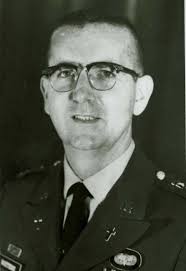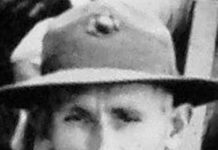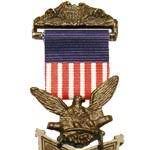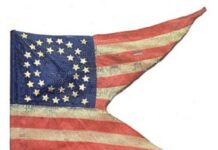Chaplains
Chaplains have been a part of the United States armed forces ever since Army chaplains put their lives on the line during the battles of Lexington and Concord in 1775. Their mission has always been to give spiritual aid as well as prayers and comfort for the military and bring spiritual peace to their flocks. But there have been many times they have led troops into battle, assisted the wounded, carried men from the battlefield, and lay beside them in trenches with enemy fire overhead.
Since the Civil War, when the first Medal s of Honor were awarded, there have only been nine chaplains who have received this highest honor paid to military. Seven of these were Army, one was Naval Reserve and one was Navy. Of the nine, two came from New York, six came from Massachusetts, Kansas, Illinois, Indiana and California.
One came from New Jersey.
Major Charles J. Watters
Meet Major Charles J. Watters, a Catholic priest from Jersey City, a graduate of Seton Hall University, and a major with the 173d Airborne Brigade of the US Army during the Vietnam War. He was born Jan. 17, 1927.
Fr. Watters was not the ordinary parish priest. He also held a commercial pilots’ license.
After graduating from Seton Hall, Father Watters went on to Immaculate Conception Seminary in Darlington, and was ordained a priest in 1953. Over the next few years, he served in parishes in Jersey City Rutherford, Cranford and Paramus in the Archdiocese of Newark., At the same time, intrigued by flying he studied and became certified as a commercial pilot. In 1962, he joined the New Jersey Air National Guard, and two years later, he signed on with the Army at Fort Dix, serving as a chaplain there.
Viet Nam
In 1966, the chaplain was assigned to the Republic of Vietnam serving with Company A, 173rd Support Battalion, 173rd Airborne Brigade. But Major Watters didn’t always stay with the support group. He frequently went with the brigade’s line units into the battlefield. Then, at the end of his 12 month tour, he requested and was granted an extension to stay with his men for another six months.
It was November 1967. The chaplain was with the 2nd Battalion, 503rd Infantry, and the men were involved in fighting for Hill 875 near Dak To. An intense fire fight broke out on Nov. 19. And men were dying on the battlefield. So Chaplain Watters did what heroic chaplains do. He rushed onto the battlefield and began picking up the wounded and bringing them back to safety. Then he brought back those who had been killed. He administered the Last Rites of the Catholic Church to the dying and continued his mission of helping his soldiers on the front line.
The fighting and killing went on for hours, yet Chaplain Watters maintained his own composure, inspired his soldiers and continued his mission to help bring the fallen to safety. He assisted medics with emergency care, he continued administering the last rites, he spurned every effort to stay behind the battle zone to protect himself. It was then he himself was wounded and died that day on Hill 875.
His heroism was not forgotten. Chaplain Charles Watters was the first Army chaplain to receive the Medal of Honor since the Civil War. The U.S. Army Chaplain Center and School renamed its building Watters Hall. Public School 24 in Jersey City was renamed Chaplain Charles J. Watters School.
The inscription of the Medal of Honor for Chaplain Major Charles Watters reads:
Citation
For conspicuous gallantry and intrepidity in action at the risk of his life above and beyond the call of duty. Chaplain Watters distinguished himself during an assault in the vicinity of Dak To. Chaplain Watters was moving with one of the companies when it engaged a heavily armed enemy battalion. As the battle raged and the casualties mounted, Chaplain Watters, with complete disregard for his safety, rushed forward to the line of contact. Unarmed and completely exposed, he moved among, as well as in front of the advancing troops, giving aid to the wounded, assisting in their evacuation, giving words of encouragement, and administering the last rites to the dying. When a wounded paratrooper was standing in shock in front of the assaulting forces, Chaplain Watters ran forward, picked the man up on his shoulders and carried him to safety. As the troopers battled to the first enemy entrenchment, Chaplain Watters ran through the intense enemy fire to the front of the entrenchment to aid a fallen comrade. A short time later, the paratroopers pulled back in preparation for a second assault. Chaplain Watters exposed himself to both friendly and enemy fire between the two forces in order to recover two wounded soldiers. Later, when the battalion was forced to pull back into a perimeter, Chaplain Watters noticed that several wounded soldiers were lying outside the newly formed perimeter. Without hesitation and ignoring attempts to restrain him, Chaplain Watters left the perimeter three times in the face of small arms, automatic weapons, and mortar fire to carry and to assist the injured troopers to safety. Satisfied that all of the wounded were inside the perimeter, he began aiding the medics … applying field bandages to open wounds, obtaining and serving food and water, giving spiritual and mental strength and comfort. During his ministering, he moved out to the perimeter from position to position redistributing food and water, and tending to the needs of his men. Chaplain Watters was giving aid to the wounded when he himself was mortally wounded. Chaplain Watters’ unyielding perseverance and selfless devotion to his comrades was in keeping with the highest traditions of the U.S. Army.
Presentation
The Medal of Honor was presented to the fallen chaplain’s family posthumously by Vice President Spiro Agnew on Nov. 19, 1967.
Major Watters is buried in Arlington National Cemetery.
Also in this series




